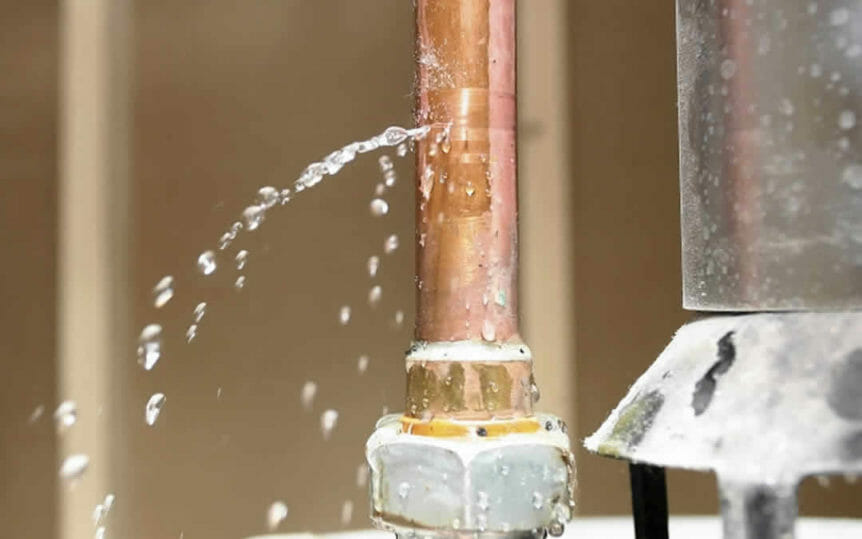
Different Ways Your Plumbing Can Spring A Leak And How To Detect The Problems
Water leaks in the home can happen anywhere, anytime. Something that starts out as a small drip can turn into a major leak that floods your home. Most of the time it catches you off guard. See, all leaks start out small, a drip here and a drip there. But as time goes by these leaks become more powerful until they are big enough to cause serious damage. But if you’re like most homeowners, you don’t really know what to look for when it comes to leaks so trying to figure out where the next one will strike is difficult.
“There are a lot of ways a home can spring a leak and you will never be able to catch them all before they happen because of the location of the pipes in your home,” said John Moore Services Plumbing and Operations Manager Joe Bany. “But there are some external things to look for that will help you spot problems with your pipes, and if you catch these issues early you can help prevent leakage.”
You might have a risk for a plumbing leak if you have:
Galvanized or copper piping. Years ago it was common practice to use pipes made of galvanized steel or copper . We now know that these materials are not ideal for the home and will develop cancer spots and eventually burst. If your home is older and you know that your piping system has not been replaced, then chances are you will spring a leak. As these materials begin to age you will notice rust spots, calcium buildup, and white flaky spots on connection points throughout your home. These are indicators that a leak is going to happen soon and are a warning to get professional help.
Calcium buildup. Calcium buildup on drains, supply lines to toilets, angle stops, and emergency stops are a sign that water is leaking and there is an issue that needs to be addressed. Any time water is slowly leaking it will leave behind calcium spots because of the minerals that are in our Houston water. These spots tell a professional that there is an internal problem and something inside is beyond the point of normal use and function. Although the leak has not exploded yet, it’s only a matter of time.
Hard water buildup. Many homeowners have noticed their kitchen or bathroom faucets starting to tarnish and develop a white buildup. This again is due to our water quality. The minerals in our water attack the inside of our drains and pipes and will eventually cause them to leak. Any signs you see on the outside are also happening on the inside of the faucet where the valve is located. And what you can see is never as bad as what you can’t see. The more tarnished and worn down internal valves become the more likely they are to spring a leak.
Bubbles in supply lines. Supply lines are responsible for bring water and gas from the pipes inside your walls to fixtures and appliances throughout your home. A supply line in good shape looks like a flexible white tube with mesh around it. As they get older they will start to develop bubbles, just like a car tire. And eventually these bubbles will burst.
“It’s a good idea to watch out for these key indicators because if you notice them getting worse you are that much closer to leakage,” said Bany. “It is also important to watch out for the major systems in your home, like your ac unit. These are large and expensive systems and when a leak occurs the damage is going to be severe.”
Don’t forget to inspect the following in your home on a regular basis
Water heater. Not all water heater bursts happen at the tank like most people think; some happen at connection points. There are always warning signs that appear before they burst to tell you something is not right. Calcium buildup on connection points, water in the drain pan, or rust stains in the drain pan are all visual signs that indicate something is wrong internally.
Safety drains. Most homes have 2 or 3 plastic pipes outside that exit the home and are usually about a foot away from the ground. They are called safety drains. One is for the ac drain pan, one is for the water heater drain, and one is for the water heater safety drain line. These should be inspected regularly. Water should never be leaking out of them and if you see a drip then you have a problem.
“Safety drains are great to have because they are something every homeowner can see. Most AC systems and water heaters are in the attic, and not many people go up in the attic to inspect them,” said Bany. “But if you see water coming out of the safety drains then there is definitely an issue with one of your systems and you should call out a professional right away.”
Drains. Always pay attention to the speed in which your kitchen, bathroom, and shower drains actually drain. Drains that are slow are signaling you that something is not working correctly and there could be a problem.
When a pipe bursts in any part of the home it creates a lot of damage. And it usually happens when you least expect it. But by paying attention to the signs listed above you can stay one step ahead of leakage. If you notice corrosion or other buildup anywhere in your home call the expert plumbers at John Moore Services. We can fix the small problem before it becomes a major leak so that you don’t need a plumber and a contractor to fix the damage
